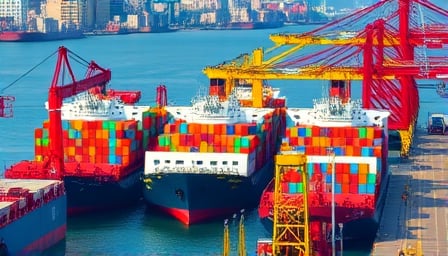Wallenius Wilhelmsen ASA Faces a 5 % Share Decline as Shipping Rates Fall
Wallenius Wilhelmsen ASA (OSLO: WLN) has suffered a sharp 5 % drop in its share price on 7 October 2025, a reaction that follows a broader contraction in freight rates across the global shipping market. The fall, recorded at a closing price of 90.1 NOK, reflects investors’ growing concern that the company’s core revenue streams are being eroded by market pressures that have been evident for several weeks.
The decline is mirrored in the German-language version of the news, “Sinkende Frachtraten belasten Wallenius Wilhelmsen – Aktie gibt 5 % nach,” confirming that the same catalyst—reduced freight rates—is affecting the company’s valuation across multiple markets. The parallel coverage underscores that the issue is not a local anomaly but a sector-wide challenge.
Underlying Financial Performance: A Mixed Picture
While the share price is in the red, the company’s recent earnings data paints a more nuanced portrait. According to a report from The Sea Nation, the firm reported an EBITDA of USD 472 million for the second quarter of 2025, with total revenues of USD 1.350 billion—a 2 % rise QoQ driven by robust performance in its vehicle logistics segment. These figures suggest that, despite declining freight rates, the company’s diversified business model—spanning roll‑on/roll‑off shipping, vehicle logistics, and inland distribution—continues to generate steady cash flow.
However, the EBITDA margin’s modest growth cannot fully offset the broader trend of falling freight rates, which compress earnings before interest, taxes, depreciation, and amortization across the maritime transport industry. Wallenius Wilhelmsen’s 52‑week low of 55.25 NOK (on 6 April 2025) and high of 131.1 NOK (on 10 October 2024) illustrate the volatility of the market and the sensitivity of the company’s valuation to freight dynamics.
Market Valuation and Investor Sentiment
With a market capitalisation of approximately 3.56 billion NOK and a price‑earnings ratio of 3.47, Wallenius Wilhelmsen trades at a discount relative to many of its peers. The low P/E suggests that investors are already pricing in a potential downturn, or that the company’s growth prospects are limited by structural changes in shipping demand. The 5 % share decline on a single day is a stark reminder that market sentiment can shift quickly when external pressures—such as falling freight rates—materialise.
Strategic Implications
The company’s fleet of 123 vessels, acquired as of 31 December 2018, represents a significant capital commitment. A sustained downturn in freight rates could lead to underutilisation of this fleet, eroding economies of scale and increasing operating costs per ton. In response, Wallenius Wilhelmsen may need to re‑evaluate its vessel utilisation strategy, possibly accelerating the retirement of older ships or renegotiating charter agreements to mitigate exposure.
Moreover, the company’s focus on vehicle logistics—providing plant‑ and port‑based technical services, marine terminal services, and inland distribution—offers a counterbalance to the pure shipping arm. This segment’s resilience in the second quarter suggests a potential avenue for stabilising revenue, but it may not be sufficient to offset the broader decline in shipping rates without strategic investment in technology, digitalisation, and service differentiation.
Conclusion
The 5 % plunge in Wallenius Wilhelmsen’s share price is a clear signal that investors are uneasy about the trajectory of global freight rates. While the company’s recent EBITDA growth and diversified operations provide some insulation, the broader industry trend threatens to compress margins across the board. For Wallenius Wilhelmsen to navigate this turbulent environment, it must leverage its logistical expertise, optimise fleet utilisation, and possibly recalibrate its growth strategy to align with the new realities of the maritime transport market.
